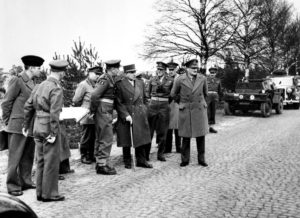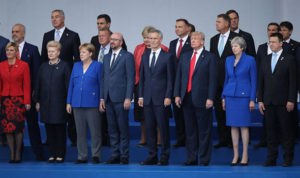During the NATO Summit in Brussels earlier this year, the President of the United States, leader of one of the founding member states of the Alliance, stunned the world when he reportedly declared – in a meeting of the heads of state and government – that the USA would “go it alone” if the Allies failed to increase defense spending. With Alliance unity considered a lynchpin of security in Europe, the mere perception of cracks in its armor could make 70 years of peace vulnerable to collapse. In response, some European Union (EU) members are reviving an old idea and seeking to reverse Europe’s reliance for its security on the United States by creating another military apparatus: the European Army. To some, the concept is a fool’s errand. It runs counter to NATO and is at odds with the EU’s purpose. More importantly, it is harmful to the relationship between Europe and the United States.
Fundamentals
“World peace cannot be safeguarded without the making of creative efforts proportionate to the dangers which threaten it.”
– Robert Schuman
In 1946, as Europe struggled to rebuild after the Second World War, a young State Department official named George Kennan wrote there could be “no permanent peaceful coexistence” with the Soviet Union. With those few words, Kennan summarized the political reality that would dominate American strategic thinking for the next 50 years. Thereafter, the looming Soviet threat forced western European nations toward greater military and economic integration and inspired support from the United States which otherwise would have retreated into its traditional isolationism. Announcing his plan for the recovery of Europe, George Marshall, then US Secretary of State, claimed the “remedy [to prevent further deterioration] lies in…restoring the confidence of the European people in the economic future of their own countries and of Europe as a whole.” As Nicolaus Mills explains, “the genius of the Marshall Plan was that it enabled the countries of Western Europe to look upon one another not as rivals competing in a zero-sum game but as partners with a chance to gain from each other through liberalized trade and interchangeable currencies made reliable by American backing.” European security, at least in the American view, began with sound economic fundamentals.
Unfortunately, the USSR remained undeterred and continued to spread Communist influence throughout Eastern Europe. On April 4th, 1949, as a result of this seemingly uncontested expansion, twelve European nations and the United States ratified the Washington Treaty establishing NATO as a mechanism to deter and repel Soviet aggression. Accordingly, European countries began integrating their economies through a series of treaties that provided a formal construct for their collective economic interests. The European Coal and Steel Community (ECSC), the European Economic Community (EEC), and the European Atomic Energy Community (EAEC), among others, fostered a cooperative international environment whereby each nation could better control its destiny. Perhaps by design, they also formed the foundations of what would become the European Union.

Concerned about the overwhelming combat power of the Red Army in 1950, the US Joint Chiefs of Staff (JCS) contended “the appropriate and early rearming of Western Germany is of fundamental importance to the defense of Western Europe against the USSR.” France vehemently opposed this idea and offered an alternative. Designed to stop German rearmament, the French Plan, designed by Defense Minister René Pleven, called for a highly integrated European Army. The UK worried Pleven’s “European Defense Community” (EDC) might weaken NATO, but did not refuse the treaty outright. The American government, an early advocate for rearming Germany, questioned the logic of Pleven’s proposal. The US Secretary of State, Dean Acheson, claimed the EDC was “hastily conceived without serious military advice… unrealistic and undesirable.” In the eyes of western officials, the Pleven Plan, and ultimately the EDC, would result in “duplication, confusion and divided responsibility.” Though several European nations agreed to the terms contained within the Treaty Establishing the European Defense Community on May 27, 1952, the French Parliament refused to ratify it. The EDC collapsed and the allies quickly integrated the Federal Republic of Germany into NATO, allowing West Germany to rearm under a “collective self-defense” organization. France’s concern for German rearmament subsided, and with it, the push for an army outside NATO became a great taboo of the Cold War.
The European Army Reemerges

Contemporary politics and a shaky transatlantic relationship are the rationales behind the European Army’s recent resurgence. US President Trump’s demand for NATO allies to pay their “fair share and meet their financial obligations” enflames Europe’s desire to extricate itself from the US-dominated security relationship. Jean-Claude Juncker, the European Commission President, expressed this sentiment in a 2015 interview saying, “A joint EU army would show the world that there would never again be a war between EU countries… such an army would also help us to form common foreign and security policies and allow Europe to take on responsibility in the world… a common European army would convey a clear message to Russia that we are serious about defending our European values.”
It is therefore unsurprising the EU began developing a joint military investment strategy exclusive of NATO and the United States in November 2017. Under the Permanent Structured Cooperation (PESCO) agreement, EU members agreed to leverage their combined economies of scale while not explicitly adhering to NATO’s defense spending goal of two-percent gross domestic product (GDP). Responding to US concerns that an increase in EU defense spending could distract from NATO activities, the European Council President, Donald Tusk, warned the United States to “appreciate [its] allies, after all [it doesn’t] have that many.” The rhetorical back-and-forth between western nations continues to drive the United States and its European allies farther apart and provides fodder for some to demand a robust, Europe-only, military apparatus. In late August, French President Emmanuel Macron verbalized this idea, telling European ambassadors “Europe [could] no longer entrust its security to the United States alone. It’s up to us to guarantee our security.”
A Tale Not Worth Retelling
Overt discussion of an extra-NATO military organization is no longer the great taboo it was during the Cold War, but the European Army generates more questions than it answers. The stated aim of the European Union was to end “the frequent and bloody wars between neighbors” by creating a common economic and financial market for European nations. It was never intended to compete with NATO as a provider of multi-lateral military power. The logic the UK used to protest the EDC in the 1950s is still applicable today; that a vote for the European Army dilutes NATO’s resources, degrades its unity of effort, and convolutes the EU’s purpose. With over 70 years of experience working through common funding, command-and-control, training, standardization, doctrine, and capability development, NATO remains the gold standard of collective defense. By contrast, Europe has not developed protocols for controlling the European Army, resolving conflicts between member states, or even disputes between those member states and the EU itself.
European leaders should recognize the dangers of moving forward with their own military unless their long-term goal is to mitigate US influence over European military spending. Perhaps goaded by spite for the current US Administration, Europe is on the brink of a major strategic error. In this tale of two armies, an untested and unfunded European Army is not only a poor substitute for NATO, but it is also a threat to the viability of the Alliance and the security of Europe.
 Major Steve “SWAP” Nolan is a US Air Force Weapons Officer, C17 Instructor Pilot, School of Advanced Air and Space Studies (SAASS) graduate, and is currently serving as the Director of Operations for the 21st Airlift Squadron, California. He holds a Bachelor’s degree in Human Resource Management and three Master’s degrees in Business Administration and Operations Management with a focus on Air Mobility Logistics, and Military Strategy. Steve recently published an article discussing how the US Air Force can improve its talent management practices and is currently working on another article based on his SAASS thesis: Triggers, Traps, and Mackinder’s Maps – The Russian Bear, NATO, and the Near Abroad.
Major Steve “SWAP” Nolan is a US Air Force Weapons Officer, C17 Instructor Pilot, School of Advanced Air and Space Studies (SAASS) graduate, and is currently serving as the Director of Operations for the 21st Airlift Squadron, California. He holds a Bachelor’s degree in Human Resource Management and three Master’s degrees in Business Administration and Operations Management with a focus on Air Mobility Logistics, and Military Strategy. Steve recently published an article discussing how the US Air Force can improve its talent management practices and is currently working on another article based on his SAASS thesis: Triggers, Traps, and Mackinder’s Maps – The Russian Bear, NATO, and the Near Abroad.


One thought on “A Tale of Two Armies: Defending NATO”
Comments are closed.